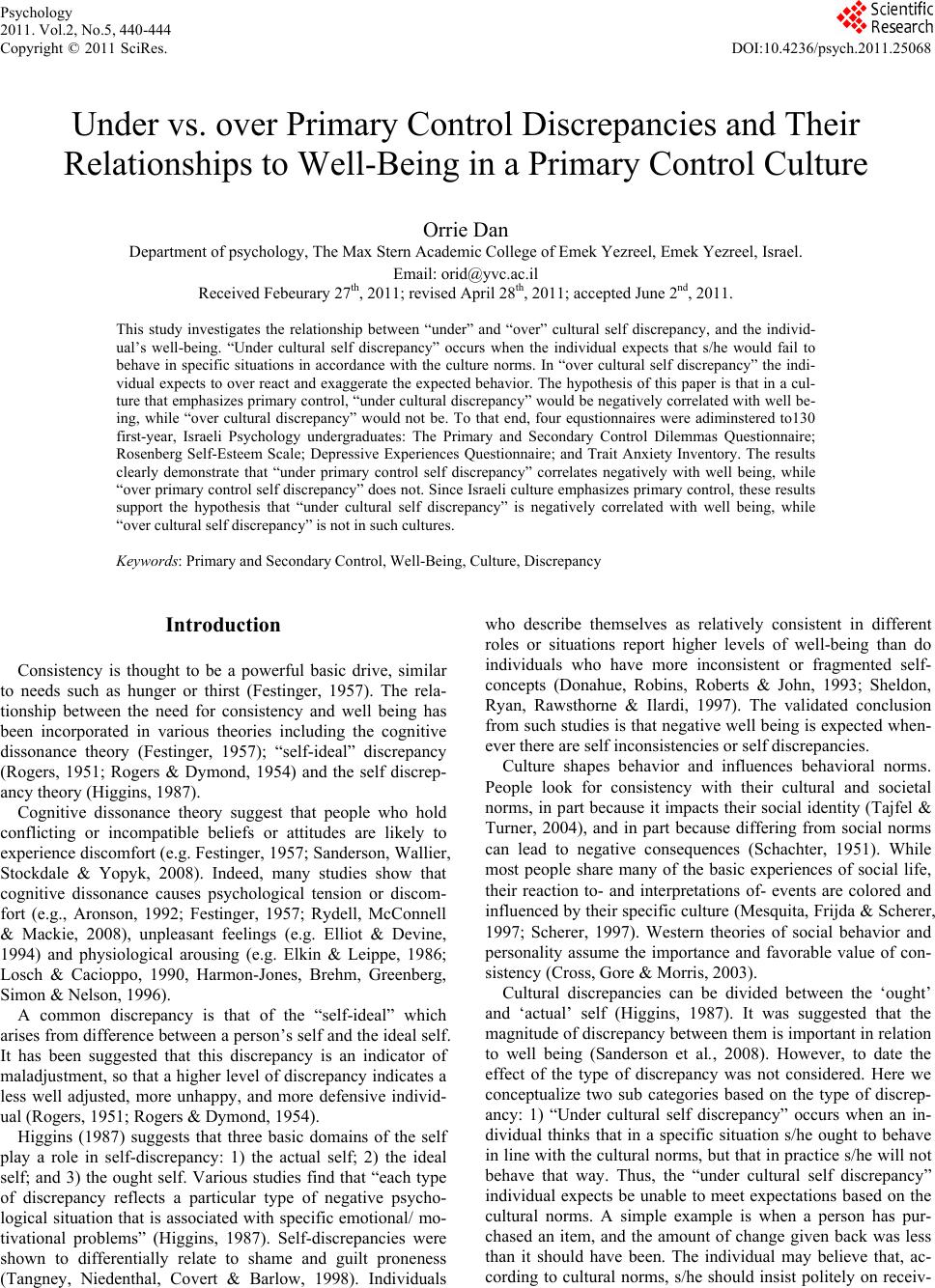 Psychology 2011. Vol.2, No.5, 440-444 Copyright © 2011 SciRes. DOI:10.4236/psych.2011.25068 Under vs. over Primary Control Discrepancies and Their Relationships to Well-Being in a Primary Control Culture Orrie Dan Department of psychology, The Max Stern Academic College of Emek Yezreel, Emek Yezreel, Israel. Email: orid@yvc.ac.il Received Febeurary 27th, 2011; revised April 28th, 2011; accepted June 2nd, 2011. This study investigates the relationship between “under” and “over” cultural self discrepancy, and the individ- ual’s well-being. “Under cultural self discrepancy” occurs when the individual expects that s/he would fail to behave in specific situations in accordance with the culture norms. In “over cultural self discrepancy” the indi- vidual expects to over react and exaggerate the expected behavior. The hypothesis of this paper is that in a cul- ture that emphasizes primary control, “under cultural discrepancy” would be negatively correlated with well be- ing, while “over cultural discrepancy” would not be. To that end, four equstionnaires were adiminstered to130 first-year, Israeli Psychology undergraduates: The Primary and Secondary Control Dilemmas Questionnaire; Rosenberg Self-Esteem Scale; Depressive Experiences Questionnaire; and Trait Anxiety Inventory. The results clearly demonstrate that “under primary control self discrepancy” correlates negatively with well being, while “over primary control self discrepancy” does not. Since Israeli culture emphasizes primary control, these results support the hypothesis that “under cultural self discrepancy” is negatively correlated with well being, while “over cultural self discrepancy” is not in such cultures. Keywords: Primary and Secondary Control, Well-Being, Culture, Discrepancy Introduction Consistency is thought to be a powerful basic drive, similar to needs such as hunger or thirst (Festinger, 1957). The rela- tionship between the need for consistency and well being has been incorporated in various theories including the cognitive dissonance theory (Festinger, 1957); “self-ideal” discrepancy (Rogers, 1951; Rogers & Dymond, 1954) and the self discrep- ancy theory (Higgins, 1987). Cognitive dissonance theory suggest that people who hold conflicting or incompatible beliefs or attitudes are likely to experience discomfort (e.g. Festinger, 1957; Sanderson, Wallier, Stockdale & Yopyk, 2008). Indeed, many studies show that cognitive dissonance causes psychological tension or discom- fort (e.g., Aronson, 1992; Festinger, 1957; Rydell, McConnell & Mackie, 2008), unpleasant feelings (e.g. Elliot & Devine, 1994) and physiological arousing (e.g. Elkin & Leippe, 1986; Losch & Cacioppo, 1990, Harmon-Jones, Brehm, Greenberg, Simon & Nelson, 1996). A common discrepancy is that of the “self-ideal” which arises from difference between a person’s self and the ideal self. It has been suggested that this discrepancy is an indicator of maladjustment, so that a higher level of discrepancy indicates a less well adjusted, more unhappy, and more defensive individ- ual (Rogers, 1951; Rogers & Dymond, 1954). Higgins (1987) suggests that three basic domains of the self play a role in self-discrepancy: 1) the actual self; 2) the ideal self; and 3) the ought self. Various studies find that “each type of discrepancy reflects a particular type of negative psycho- logical situation that is associated with specific emotional/ mo- tivational problems” (Higgins, 1987). Self-discrepancies were shown to differentially relate to shame and guilt proneness (Tangney, Niedenthal, Covert & Barlow, 1998). Individuals who describe themselves as relatively consistent in different roles or situations report higher levels of well-being than do individuals who have more inconsistent or fragmented self- concepts (Donahue, Robins, Roberts & John, 1993; Sheldon, Ryan, Rawsthorne & Ilardi, 1997). The validated conclusion from such studies is that negative well being is expected when- ever there are self inconsistencies or self discrepancies. Culture shapes behavior and influences behavioral norms. People look for consistency with their cultural and societal norms, in part because it impacts their social identity (Tajfel & Turner, 2004), and in part because differing from social norms can lead to negative consequences (Schachter, 1951). While most people share many of the basic experiences of social life, their reaction to- and interpretations of- events are colored and influenced by their specific culture (Mesquita, Frijda & Scherer, 1997; Scherer, 1997). Western theories of social behavior and personality assume the importance and favorable value of con- sistency (Cross, Gore & Morris, 2003). Cultural discrepancies can be divided between the ‘ought’ and ‘actual’ self (Higgins, 1987). It was suggested that the magnitude of discrepancy between them is important in relation to well being (Sanderson et al., 2008). However, to date the effect of the type of discrepancy was not considered. Here we conceptualize two sub categories based on the type of discrep- ancy: 1) “Under cultural self discrepancy” occurs when an in- dividual thinks that in a specific situation s/he ought to behave in line with the cultural norms, but that in practice s/he will not behave that way. Thus, the “under cultural self discrepancy” individual expects be unable to meet expectations based on the cultural norms. A simple example is when a person has pur- chased an item, and the amount of change given back was less than it should have been. The individual may believe that, ac- cording to cultural norms, s/he should insist politely on receiv- 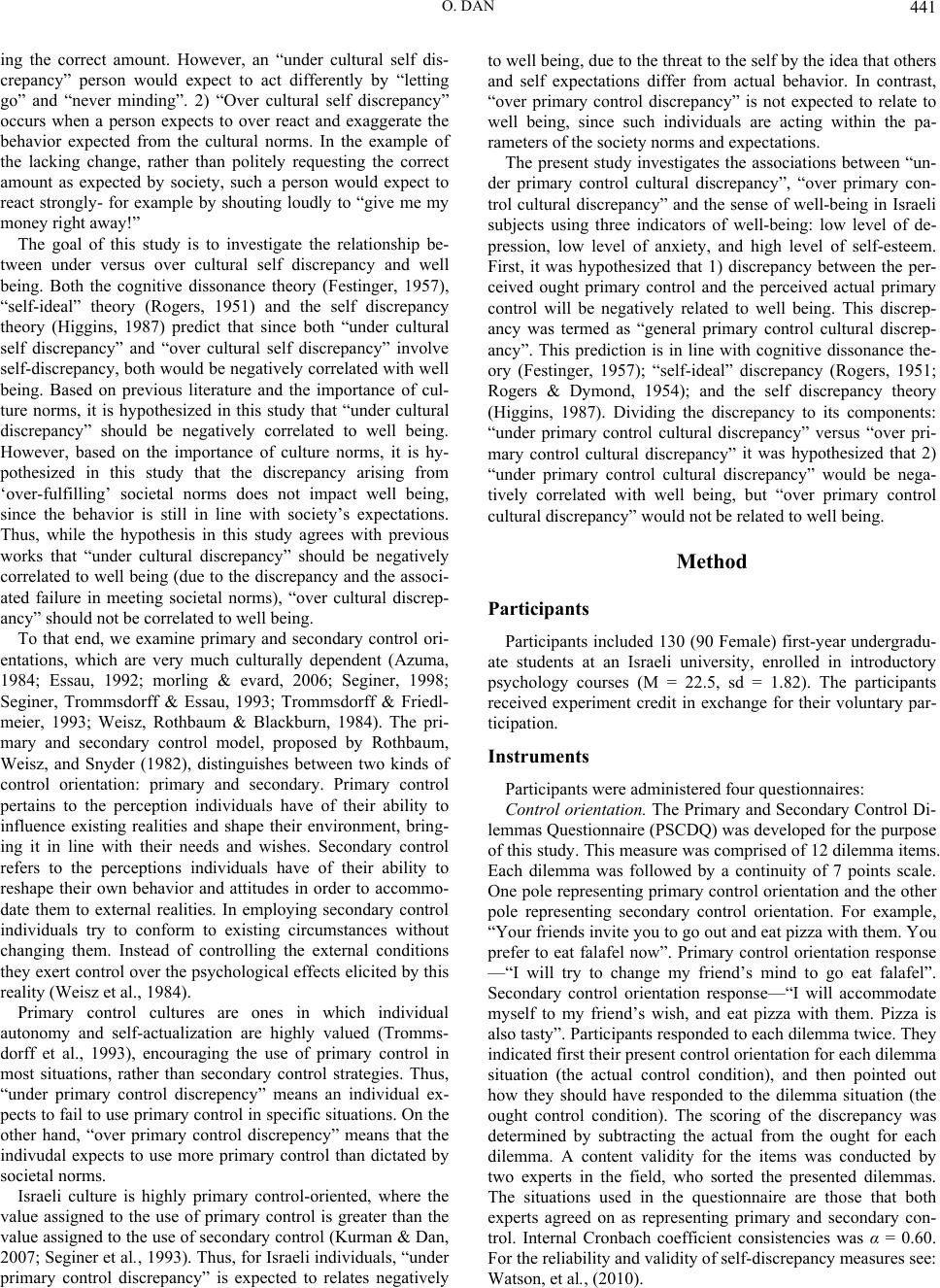 O. DAN 441 ing the correct amount. However, an “under cultural self dis- crepancy” person would expect to act differently by “letting go” and “never minding”. 2) “Over cultural self discrepancy” occurs when a person expects to over react and exaggerate the behavior expected from the cultural norms. In the example of the lacking change, rather than politely requesting the correct amount as expected by society, such a person would expect to react strongly- for example by shouting loudly to “give me my money right away!” The goal of this study is to investigate the relationship be- tween under versus over cultural self discrepancy and well being. Both the cognitive dissonance theory (Festinger, 1957), “self-ideal” theory (Rogers, 1951) and the self discrepancy theory (Higgins, 1987) predict that since both “under cultural self discrepancy” and “over cultural self discrepancy” involve self-discrepancy, both would be negatively correlated with well being. Based on previous literature and the importance of cul- ture norms, it is hypothesized in this study that “under cultural discrepancy” should be negatively correlated to well being. However, based on the importance of culture norms, it is hy- pothesized in this study that the discrepancy arising from ‘over-fulfilling’ societal norms does not impact well being, since the behavior is still in line with society’s expectations. Thus, while the hypothesis in this study agrees with previous works that “under cultural discrepancy” should be negatively correlated to well being (due to the discrepancy and the associ- ated failure in meeting societal norms), “over cultural discrep- ancy” should not be correlated to well being. To that end, we examine primary and secondary control ori- entations, which are very much culturally dependent (Azuma, 1984; Essau, 1992; morling & evard, 2006; Seginer, 1998; Seginer, Trommsdorff & Essau, 1993; Trommsdorff & Friedl- meier, 1993; Weisz, Rothbaum & Blackburn, 1984). The pri- mary and secondary control model, proposed by Rothbaum, Weisz, and Snyder (1982), distinguishes between two kinds of control orientation: primary and secondary. Primary control pertains to the perception individuals have of their ability to influence existing realities and shape their environment, bring- ing it in line with their needs and wishes. Secondary control refers to the perceptions individuals have of their ability to reshape their own behavior and attitudes in order to accommo- date them to external realities. In employing secondary control individuals try to conform to existing circumstances without changing them. Instead of controlling the external conditions they exert control over the psychological effects elicited by this reality (Weisz et al., 1984). Primary control cultures are ones in which individual autonomy and self-actualization are highly valued (Tromms- dorff et al., 1993), encouraging the use of primary control in most situations, rather than secondary control strategies. Thus, “under primary control discrepency” means an individual ex- pects to fail to use primary control in specific situations. On the other hand, “over primary control discrepency” means that the indivudal expects to use more primary control than dictated by societal norms. Israeli culture is highly primary control-oriented, where the value assigned to the use of primary control is greater than the value assigned to the use of secondary control (Kurman & Dan, 2007; Seginer et al., 1993). Thus, for Israeli individuals, “under primary control discrepancy” is expected to relates negatively to well being, due to the threat to the self by the idea that others and self expectations differ from actual behavior. In contrast, “over primary control discrepancy” is not expected to relate to well being, since such individuals are acting within the pa- rameters of the society norms and expectations. The present study investigates the associations between “un- der primary control cultural discrepancy”, “over primary con- trol cultural discrepancy” and the sense of well-being in Israeli subjects using three indicators of well-being: low level of de- pression, low level of anxiety, and high level of self-esteem. First, it was hypothesized that 1) discrepancy between the per- ceived ought primary control and the perceived actual primary control will be negatively related to well being. This discrep- ancy was termed as “general primary control cultural discrep- ancy”. This prediction is in line with cognitive dissonance the- ory (Festinger, 1957); “self-ideal” discrepancy (Rogers, 1951; Rogers & Dymond, 1954); and the self discrepancy theory (Higgins, 1987). Dividing the discrepancy to its components: “under primary control cultural discrepancy” versus “over pri- mary control cultural discrepancy” it was hypothesized that 2) “under primary control cultural discrepancy” would be nega- tively correlated with well being, but “over primary control cultural discrepancy” would not be related to well being. Method Participants Participants included 130 (90 Female) first-year undergradu- ate students at an Israeli university, enrolled in introductory psychology courses (M = 22.5, sd = 1.82). The participants received experiment credit in exchange for their voluntary par- ticipation. Instruments Participants were administered four questionnaires: Control orientation. The Primary and Secondary Control Di- lemmas Questionnaire (PSCDQ) was developed for the purpose of this study. This measure was comprised of 12 dilemma items. Each dilemma was followed by a continuity of 7 points scale. One pole representing primary control orientation and the other pole representing secondary control orientation. For example, “Your friends invite you to go out and eat pizza with them. You prefer to eat falafel now”. Primary control orientation response —“I will try to change my friend’s mind to go eat falafel”. Secondary control orientation response—“I will accommodate myself to my friend’s wish, and eat pizza with them. Pizza is also tasty”. Participants responded to each dilemma twice. They indicated first their present control orientation for each dilemma situation (the actual control condition), and then pointed out how they should have responded to the dilemma situation (the ought control condition). The scoring of the discrepancy was determined by subtracting the actual from the ought for each dilemma. A content validity for the items was conducted by two experts in the field, who sorted the presented dilemmas. The situations used in the questionnaire are those that both experts agreed on as representing primary and secondary con- trol. Internal Cronbach coefficient consistencies was α = 0.60. For the reliability and validity of self-discrepancy measures see: Watson, et al., (2010). 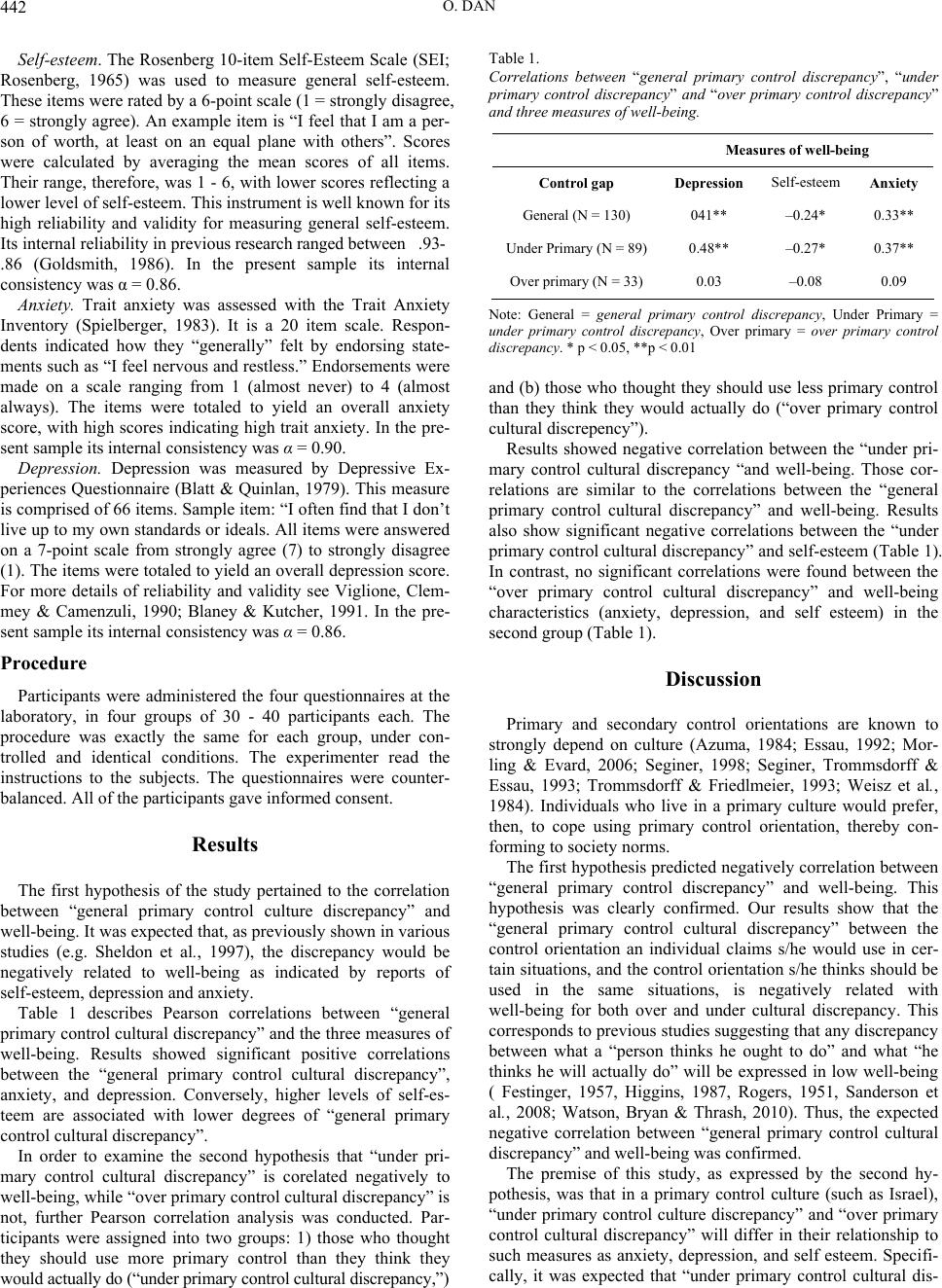 O. DAN 442 Self-esteem. The Rosenberg 10-item Self-Esteem Scale (SEI; Rosenberg, 1965) was used to measure general self-esteem. These items were rated by a 6-point scale (1 = strongly disagree, 6 = strongly agree). An example item is “I feel that I am a per- son of worth, at least on an equal plane with others”. Scores were calculated by averaging the mean scores of all items. Their range, therefore, was 1 - 6, with lower scores reflecting a lower level of self-esteem. This instrument is well known for its high reliability and validity for measuring general self-esteem. Its internal reliability in previous research ranged between 93 .- 86. (Goldsmith, 1986). In the present sample its internal consistency was α = 0.86. Anxiety. Trait anxiety was assessed with the Trait Anxiety Inventory (Spielberger, 1983). It is a 20 item scale. Respon- dents indicated how they “generally” felt by endorsing state- ments such as “I feel nervous and restless.” Endorsements were made on a scale ranging from 1 (almost never) to 4 (almost always). The items were totaled to yield an overall anxiety score, with high scores indicating high trait anxiety. In the pre- sent sample its internal consistency was α = 0.90. Depression. Depression was measured by Depressive Ex- periences Questionnaire (Blatt & Quinlan, 1979). This measure is comprised of 66 items. Sample item: “I often find that I don’t live up to my own standards or ideals. All items were answered on a 7-point scale from strongly agree (7) to strongly disagree (1). The items were totaled to yield an overall depression score. For more details of reliability and validity see Viglione, Clem- mey & Camenzuli, 1990; Blaney & Kutcher, 1991. In the pre- sent sample its internal consistency was α = 0.86. Procedure Participants were administered the four questionnaires at the laboratory, in four groups of 30 - 40 participants each. The procedure was exactly the same for each group, under con- trolled and identical conditions. The experimenter read the instructions to the subjects. The questionnaires were counter- balanced. All of the participants gave informed consent. Results The first hypothesis of the study pertained to the correlation between “general primary control culture discrepancy” and well-being. It was expected that, as previously shown in various studies (e.g. Sheldon et al., 1997), the discrepancy would be negatively related to well-being as indicated by reports of self-esteem, depression and anxiety. Table 1 describes Pearson correlations between “general primary control cultural discrepancy” and the three measures of well-being. Results showed significant positive correlations between the “general primary control cultural discrepancy”, anxiety, and depression. Conversely, higher levels of self-es- teem are associated with lower degrees of “general primary control cultural discrepancy”. In order to examine the second hypothesis that “under pri- mary control cultural discrepancy” is corelated negatively to well-being, while “over primary control cultural discrepancy” is not, further Pearson correlation analysis was conducted. Par- ticipants were assigned into two groups: 1) those who thought they should use more primary control than they think they would actually do (“under primary control cultural discrepancy,”) Table 1. Correlations between “general primary control discrepancy”, “under primary control discrepancy” and “over primary control discrepancy” and three measures of well-being. Measures of well-being Control gap Depression Self-esteem Anxiety General (N = 130) 041** –0.24* 0.33** Under Primary (N = 89)0.48** –0.27* 0.37** Over primary (N = 33) 0.03 –0.08 0.09 Note: General = general primary control discrepancy, Under Primary = under primary control discrepancy, Over primary = over primary control discrepancy. * p < 0.05, **p < 0.01 and (b) those who thought they should use less primary control than they think they would actually do (“over primary control cultural discrepency”). Results showed negative correlation between the “under pri- mary control cultural discrepancy “and well-being. Those cor- relations are similar to the correlations between the “general primary control cultural discrepancy” and well-being. Results also show significant negative correlations between the “under primary control cultural discrepancy” and self-esteem (Table 1). In contrast, no significant correlations were found between the “over primary control cultural discrepancy” and well-being characteristics (anxiety, depression, and self esteem) in the second group (Table 1). Discussion Primary and secondary control orientations are known to strongly depend on culture (Azuma, 1984; Essau, 1992; Mor- ling & Evard, 2006; Seginer, 1998; Seginer, Trommsdorff & Essau, 1993; Trommsdorff & Friedlmeier, 1993; Weisz et al., 1984). Individuals who live in a primary culture would prefer, then, to cope using primary control orientation, thereby con- forming to society norms. The first hypothesis predicted negatively correlation between “general primary control discrepancy” and well-being. This hypothesis was clearly confirmed. Our results show that the “general primary control cultural discrepancy” between the control orientation an individual claims s/he would use in cer- tain situations, and the control orientation s/he thinks should be used in the same situations, is negatively related with well-being for both over and under cultural discrepancy. This corresponds to previous studies suggesting that any discrepancy between what a “person thinks he ought to do” and what “he thinks he will actually do” will be expressed in low well-being ( Festinger, 1957, Higgins, 1987, Rogers, 1951, Sanderson et al., 2008; Watson, Bryan & Thrash, 2010). Thus, the expected negative correlation between “general primary control cultural discrepancy” and well-being was confirmed. The premise of this study, as expressed by the second hy- pothesis, was that in a primary control culture (such as Israel), “under primary control culture discrepancy” and “over primary control cultural discrepancy” will differ in their relationship to such measures as anxiety, depression, and self esteem. Specifi- cally, it was expected that “under primary control cultural dis- 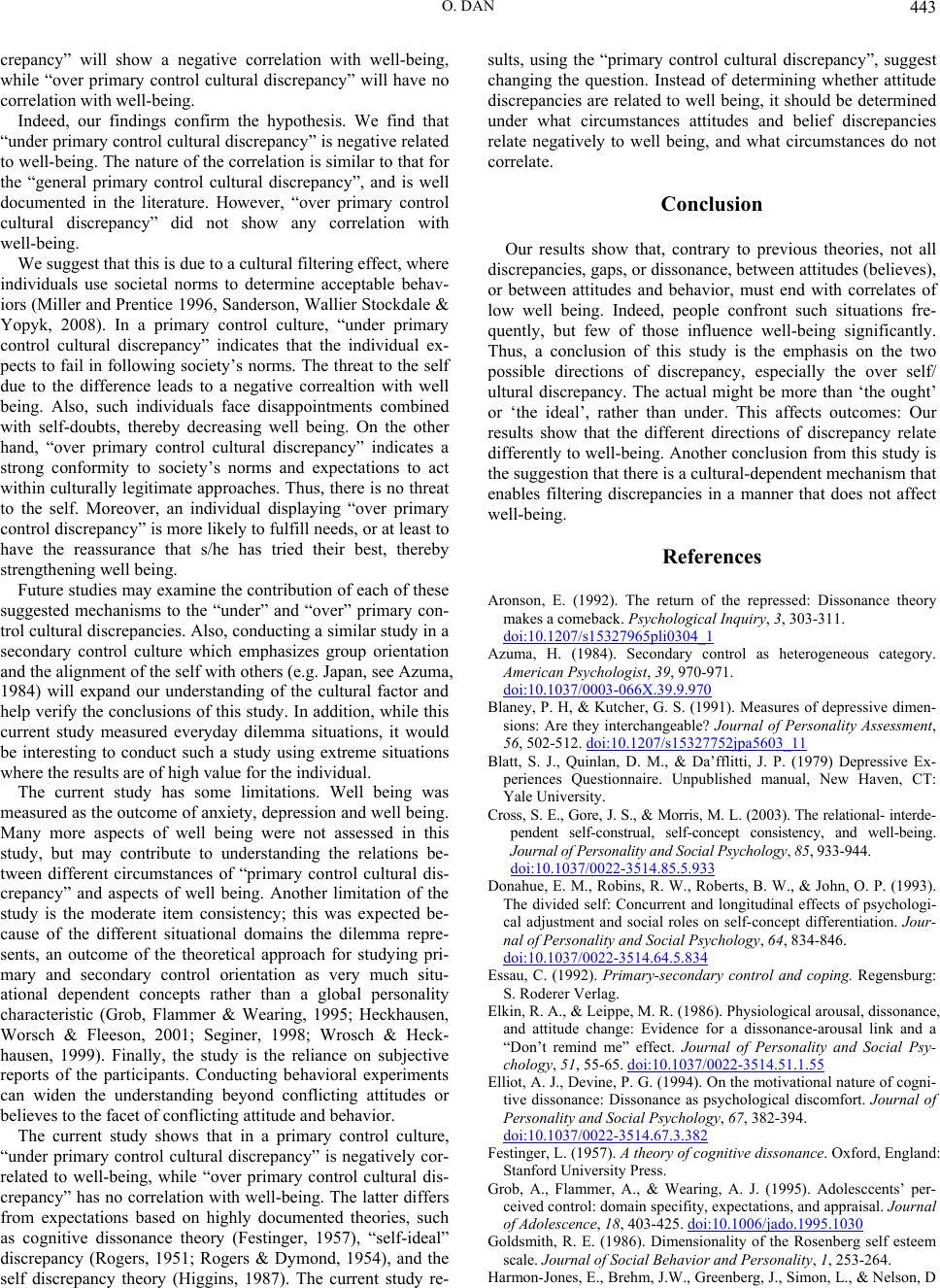 O. DAN 443 crepancy” will show a negative correlation with well-being, while “over primary control cultural discrepancy” will have no correlation with well-being. Indeed, our findings confirm the hypothesis. We find that “under primary control cultural discrepancy” is negative related to well-being. The nature of the correlation is similar to that for the “general primary control cultural discrepancy”, and is well documented in the literature. However, “over primary control cultural discrepancy” did not show any correlation with well-being. We suggest that this is due to a cultural filtering effect, where individuals use societal norms to determine acceptable behav- iors (Miller and Prentice 1996, Sanderson, Wallier Stockdale & Yopyk, 2008). In a primary control culture, “under primary control cultural discrepancy” indicates that the individual ex- pects to fail in following society’s norms. The threat to the self due to the difference leads to a negative correaltion with well being. Also, such individuals face disappointments combined with self-doubts, thereby decreasing well being. On the other hand, “over primary control cultural discrepancy” indicates a strong conformity to society’s norms and expectations to act within culturally legitimate approaches. Thus, there is no threat to the self. Moreover, an individual displaying “over primary control discrepancy” is more likely to fulfill needs, or at least to have the reassurance that s/he has tried their best, thereby strengthening well being. Future studies may examine the contribution of each of these suggested mechanisms to the “under” and “over” primary con- trol cultural discrepancies. Also, conducting a similar study in a secondary control culture which emphasizes group orientation and the alignment of the self with others (e.g. Japan, see Azuma, 1984) will expand our understanding of the cultural factor and help verify the conclusions of this study. In addition, while this current study measured everyday dilemma situations, it would be interesting to conduct such a study using extreme situations where the results are of high value for the individual. The current study has some limitations. Well being was measured as the outcome of anxiety, depression and well being. Many more aspects of well being were not assessed in this study, but may contribute to understanding the relations be- tween different circumstances of “primary control cultural dis- crepancy” and aspects of well being. Another limitation of the study is the moderate item consistency; this was expected be- cause of the different situational domains the dilemma repre- sents, an outcome of the theoretical approach for studying pri- mary and secondary control orientation as very much situ- ational dependent concepts rather than a global personality characteristic (Grob, Flammer & Wearing, 1995; Heckhausen, Worsch & Fleeson, 2001; Seginer, 1998; Wrosch & Heck- hausen, 1999). Finally, the study is the reliance on subjective reports of the participants. Conducting behavioral experiments can widen the understanding beyond conflicting attitudes or believes to the facet of conflicting attitude and behavior. The current study shows that in a primary control culture, “under primary control cultural discrepancy” is negatively cor- related to well-being, while “over primary control cultural dis- crepancy” has no correlation with well-being. The latter differs from expectations based on highly documented theories, such as cognitive dissonance theory (Festinger, 1957), “self-ideal” discrepancy (Rogers, 1951; Rogers & Dymond, 1954), and the self discrepancy theory (Higgins, 1987). The current study re- sults, using the “primary control cultural discrepancy”, suggest changing the question. Instead of determining whether attitude discrepancies are related to well being, it should be determined under what circumstances attitudes and belief discrepancies relate negatively to well being, and what circumstances do not correlate. Conclusion Our results show that, contrary to previous theories, not all discrepancies, gaps, or dissonance, between attitudes (believes), or between attitudes and behavior, must end with correlates of low well being. Indeed, people confront such situations fre- quently, but few of those influence well-being significantly. Thus, a conclusion of this study is the emphasis on the two possible directions of discrepancy, especially the over self/ ultural discrepancy. The actual might be more than ‘the ought’ or ‘the ideal’, rather than under. This affects outcomes: Our results show that the different directions of discrepancy relate differently to well-being. Another conclusion from this study is the suggestion that there is a cultural-dependent mechanism that enables filtering discrepancies in a manner that does not affect well-being. References Aronson, E. (1992). The return of the repressed: Dissonance theory makes a comeback. Psychological Inquiry, 3, 303-311. doi:10.1207/s15327965pli0304_1 Azuma, H. (1984). Secondary control as heterogeneous category. American Psychologist, 39, 970-971. doi:10.1037/0003-066X.39.9.970 Blaney, P. H, & Kutcher, G. S. (1991). Measures of depressive dimen- sions: Are they interchangeable? Journal of Personality Assessment, 56, 502-512. doi:10.1207/s15327752jpa5603_11 Blatt, S. J., Quinlan, D. M., & Da’fflitti, J. P. (1979) Depressive Ex- periences Questionnaire. Unpublished manual, New Haven, CT: Yale University. Cross, S. E., Gore, J. S., & Morris, M. L. (2003). The relational- interde- pendent self-construal, self-concept consistency, and well-being. Journal of Personality and Social Psychology, 85, 933-944. doi:10.1037/0022-3514.85.5.933 Donahue, E. M., Robins, R. W., Roberts, B. W., & John, O. P. (1993). The divided self: Concurrent and longitudinal effects of psychologi- cal adjustment and social roles on self-concept differentiation. Jour- nal of Personality and Social Psychology, 64, 834-846. doi:10.1037/0022-3514.64.5.834 Essau, C. (1992). Primary-secondary control and coping. Regensburg: S. Roderer Verlag. Elkin, R. A., & Leippe, M. R. (1986). Physiological arousal, dissonance, and attitude change: Evidence for a dissonance-arousal link and a “Don’t remind me” effect. Journal of Personality and Social Psy- chology, 51, 55-65. doi:10.1037/0022-3514.51.1.55 Elliot, A. J., Devine, P. G. (1994). On the motivational nature of cogni- tive dissonance: Dissonance as psychological discomfort. Journal of Personality and Social Psychology, 67, 382-394. doi:10.1037/0022-3514.67.3.382 Festinger, L. (1957). A theory of cognitive dissonance. Oxford, England: Stanford University Press. Grob, A., Flammer, A., & Wearing, A. J. (1995). Adolesccents’ per- ceived control: domain specifity, expectations, and appraisal. Journal of Adolescence, 18, 403-425. doi:10.1006/jado.1995.1030 Goldsmith, R. E. (1986). Dimensionality of the Rosenberg self esteem scale. Journal of Social Behavior and Personality, 1, 253-264. Harmon-Jones, E., Brehm, J.W., Greenberg, J., Simon, L., & Nelson, D 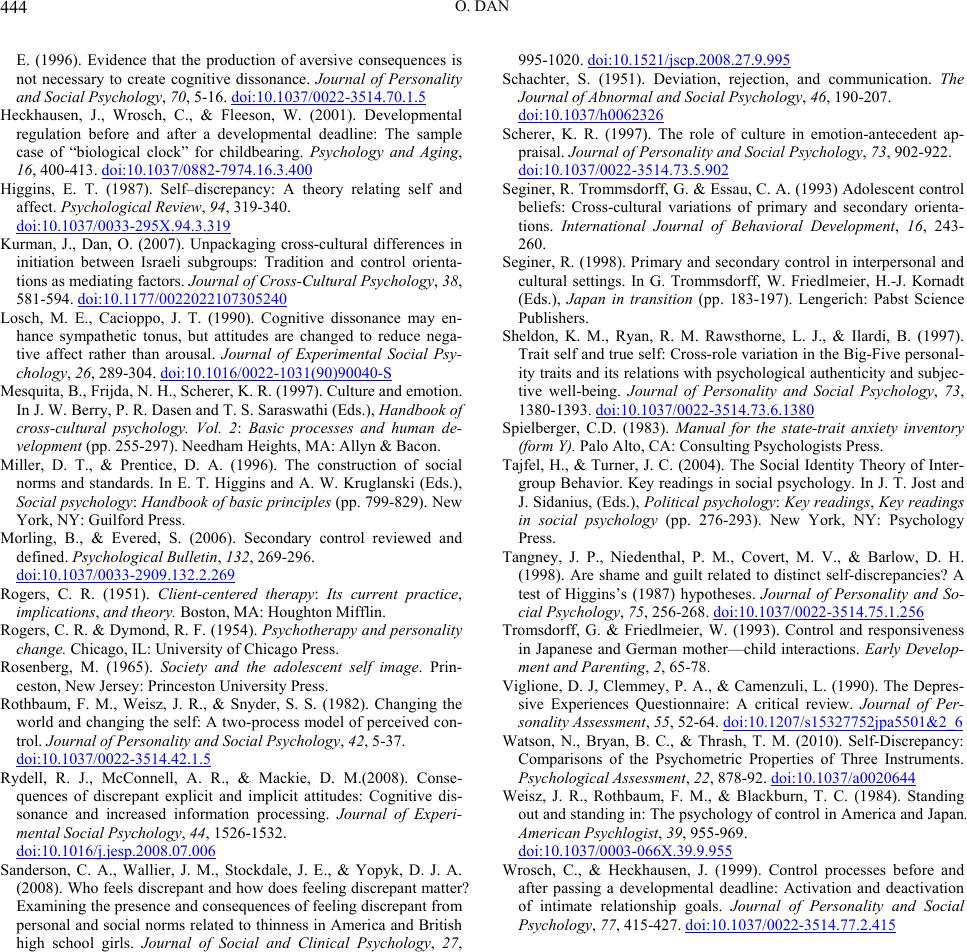 O. DAN 444 E. (1996). Evidence that the production of aversive consequences is not necessary to create cognitive dissonance. Journal of Personality and Social Psychology, 70, 5-16. doi:10.1037/0022-3514.70.1.5 Heckhausen, J., Wrosch, C., & Fleeson, W. (2001). Developmental regulation before and after a developmental deadline: The sample case of “biological clock” for childbearing. Psychology and Aging, 16, 400-413. doi:10.1037/0882-7974.16.3.400 Higgins, E. T. (1987). Self–discrepancy: A theory relating self and affect. Psychological Review, 94, 319-340. doi:10.1037/0033-295X.94.3.319 Kurman, J., Dan, O. (2007). Unpackaging cross-cultural differences in initiation between Israeli subgroups: Tradition and control orienta- tions as mediating factors. Journal of Cross-Cultural Psychology, 38, 581-594. doi:10.1177/0022022107305240 Losch, M. E., Cacioppo, J. T. (1990). Cognitive dissonance may en- hance sympathetic tonus, but attitudes are changed to reduce nega- tive affect rather than arousal. Journal of Experimental Social Psy- chology, 26, 289-304. doi:10.1016/0022-1031(90)90040-S Mesquita, B., Frijda, N. H., Scherer, K. R. (1997). Culture and emotion. In J. W. Berry, P. R. Dasen and T. S. Saraswathi (Eds.), Handbook of cross-cultural psychology. Vol. 2: Basic processes and human de- velopment (pp. 255-297). Needham Heights, MA: Allyn & Bacon. Miller, D. T., & Prentice, D. A. (1996). The construction of social norms and standards. In E. T. Higgins and A. W. Kruglanski (Eds.), Social psychology: Handbook of basic principles (pp. 799-829). New York, NY: Guilford Press. Morling, B., & Evered, S. (2006). Secondary control reviewed and defined. Psychological Bulletin, 132, 269-296. doi:10.1037/0033-2909.132.2.269 Rogers, C. R. (1951). Client-centered therapy: Its current practice, implications, and theory. Boston, MA: Houghton Mifflin. Rogers, C. R. & Dymond, R. F. (1954). Psychotherapy and personality change. Chicago, IL: University of Chicago Press. Rosenberg, M. (1965). Society and the adolescent self image. Prin- ceston, New Jersey: Princeston University Press. Rothbaum, F. M., Weisz, J. R., & Snyder, S. S. (1982). Changing the world and changing the self: A two-process model of perceived con- trol. Journal of Personality and Social Psychology, 42, 5-37. doi:10.1037/0022-3514.42.1.5 Rydell, R. J., McConnell, A. R., & Mackie, D. M.(2008). Conse- quences of discrepant explicit and implicit attitudes: Cognitive dis- sonance and increased information processing. Journal of Experi- mental Social Psychology, 44, 1526-1532. doi:10.1016/j.jesp.2008.07.006 Sanderson, C. A., Wallier, J. M., Stockdale, J. E., & Yopyk, D. J. A. (2008). Who feels discrepant and how does feeling discrepant matter? Examining the presence and consequences of feeling discrepant from personal and social norms related to thinness in America and British high school girls. Journal of Social and Clinical Psychology, 27, 995-1020. doi:10.1521/jscp.2008.27.9.995 Schachter, S. (1951). Deviation, rejection, and communication. The Journal of Abnormal and Social Psychology, 46, 190-207. doi:10.1037/h0062326 Scherer, K. R. (1997). The role of culture in emotion-antecedent ap- praisal. Journal of Personality and Social Psychology, 73, 902-922. doi:10.1037/0022-3514.73.5.902 Seginer, R. Trommsdorff, G. & Essau, C. A. (1993) Adolescent control beliefs: Cross-cultural variations of primary and secondary orienta- tions. International Journal of Behavioral Development, 16, 243- 260. Seginer, R. (1998). Primary and secondary control in interpersonal and cultural settings. In G. Trommsdorff, W. Friedlmeier, H.-J. Kornadt (Eds.), Japan in transition (pp. 183-197). Lengerich: Pabst Science Publishers. Sheldon, K. M., Ryan, R. M. Rawsthorne, L. J., & Ilardi, B. (1997). Trait self and true self: Cross-role variation in the Big-Five personal- ity traits and its relations with psychological authenticity and subjec- tive well-being. Journal of Personality and Social Psychology, 73, 1380-1393. doi:10.1037/0022-3514.73.6.1380 Spielberger, C.D. (1983). Manual for the state-trait anxiety inventory (form Y). Palo Alto, CA: Consulting Psychologists Press. Tajfel, H., & Turner, J. C. (2004). The Social Identity Theory of Inter- group Behavior. Key readings in social psychology. In J. T. Jost and J. Sidanius, (Eds.), Political psychology: Key readings, Key readings in social psychology (pp. 276-293). New York, NY: Psychology Press. Tangney, J. P., Niedenthal, P. M., Covert, M. V., & Barlow, D. H. (1998). Are shame and guilt related to distinct self-discrepancies? A test of Higgins’s (1987) hypotheses. Journal of Personality and So- cial Psychology, 75, 256-268. doi:10.1037/0022-3514.75.1.256 Tromsdorff, G. & Friedlmeier, W. (1993). Control and responsiveness in Japanese and German mother—child interactions. Early Develop- ment and Parenting, 2, 65-78. Viglione, D. J, Clemmey, P. A., & Camenzuli, L. (1990). The Depres- sive Experiences Questionnaire: A critical review. Journal of Per- sonality Assessment, 55, 52-64. doi:10.1207/s15327752jpa5501&2_6 Watson, N., Bryan, B. C., & Thrash, T. M. (2010). Self-Discrepancy: Comparisons of the Psychometric Properties of Three Instruments. Psychological Assessment, 22, 878-92. doi:10.1037/a0020644 Weisz, J. R., Rothbaum, F. M., & Blackburn, T. C. (1984). Standing out and standing in: The psychology of control in America and Japan. American Psychlogist, 39, 955-969. doi:10.1037/0003-066X.39.9.955 Wrosch, C., & Heckhausen, J. (1999). Control processes before and after passing a developmental deadline: Activation and deactivation of intimate relationship goals. Journal of Personality and Social Psychology, 77, 415-427. doi:10.1037/0022-3514.77.2.415
|